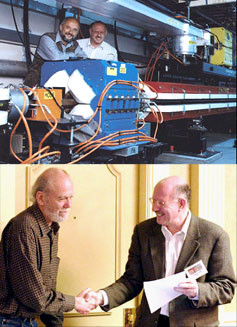

Friday - March 16, 2007
SLAC Today is
available online at:
http://today.slac.stanford.edu
In this issue:
Accolades for Jonathan
Colloquium Monday: Doubling Electron Energy in 33 Inches
Hands-on Training at SSRL
MEXT Delegations Visit, Tour the Lab
Robot Madness
 |
 |
|
Friday - March 16, 2007 |
Accolades for Jonathan
Jonathan with Fermilab Director Pier Oddone in the SLAC accelerator tunnel (top) and officially offering the position of Global Design Effort Director to Barry Barish
(bottom).
Over the past week, Jonathan has received numerous public accolades for his exceptional service to the science community. His collaboration with other science leaders has prompted them to express their admiration. Two such tributes follow. Pier Oddone, Director of Fermilab: Jonathan is an extraordinary leader for our field and for our sister institution SLAC. Through the many years that we have been friends and colleagues, I have witnessed firsthand Jonathan's great leadership abilities and his adherence to the highest principles in anything he tackles. It is easy to cite his many accomplishments.
Barry Barish, Director of the International Linear Collider Global Design
Effort: Jonathan has not only been serving as SLAC's leader
[over the past eight years], but he has also been a driving force in the world high energy physics community over the past decade. Jonathan's contributions to the field are many, but they are
epitomized by the leadership he provided to the International Committee for Future Accelerators (ICFA), which he chaired from 2003-2005. As the world of high energy physics had become more and more international, Jonathan strongly supported the many initiatives that have placed high energy physics at the very front of international collaboration in physics, and in fact in science. |
||
|
|
||

Doubling Electron Energy in 33 Inches
The experiment created one of the largest acceleration gradients—a measure of how quickly particles amass energy—ever achieved. Most of the electrons in a given bunch lost energy to the plasma, but some electrons gained 3,000 times more energy per meter than is usual in the accelerator. "The scale is pretty remarkable," said Hogan. "You need an airplane to take a picture of the two-mile linear accelerator here. Yet in a space shorter than the span of your arms, we doubled the electrons' energy to the highest ever made here. I hope in the long term it leads to extending the capabilities of existing and upcoming machines at modest costs." Hogan will discuss these results and their implications for the future of particle physics next Monday at 4:15 p.m. in Panofsky Auditorium. All are invited to attend. Hands-on SSRL Training
SSRL's short courses occur occasionally throughout the year and focus on giving interested members of the user community hands-on beamline and data-analysis training. For more information on upcoming short courses, click here. |
MEXT Delegations Visit, Tour the Lab
Robot Madness
For much of the country, March is about college basketball. But for some high school students, it's time for a different sport. "It's robot season again," said Richard Burgess, a SLAC engineer in the Controls Department. Burgess is one of the mentors for the Woodside and Carlmont High School robot team. The team will participate in the Silicon Valley Regional of the FIRST (For Inspiration and Recognition for Science and Technology) Robotics Competition at San Jose State this weekend. They will also take part in the U.C. Davis Sacramento Regional at the end of the month. Over six hectic weeks starting in January, a team of roughly 30 students designed and constructed a robot from a box of parts. Now it's time for them to pit their robot against others from regional high schools. In this year's contest, the robots will have to place inner-tubes around pegs in a giant tic-tac-toe game. The robots must be able to complete the task on their own as well as via remote control. "What we stress is that through teamwork, the students can take on a large, complicated, and almost overwhelming task, and see it through to a successful conclusion. That's the real accomplishment," Burgess said. "If they win, that's gravy." What he loves most is watching the team come together. "If it weren't for the kids, I wouldn't be doing it." |
Events (see all | submit)
Access (see all)
Announcements
|
| | ||
|
|
||
 <%
Response.AddHeader "Last-modified", getArticleDate()
'Response.AddHeader "Last-modified","Mon, 01 Sep 1997 01:03:33 GMT"
'Monday, December 06, 2010
%>
<%
Response.AddHeader "Last-modified", getArticleDate()
'Response.AddHeader "Last-modified","Mon, 01 Sep 1997 01:03:33 GMT"
'Monday, December 06, 2010
%>View online at http://today.slac.stanford.edu/. |
||